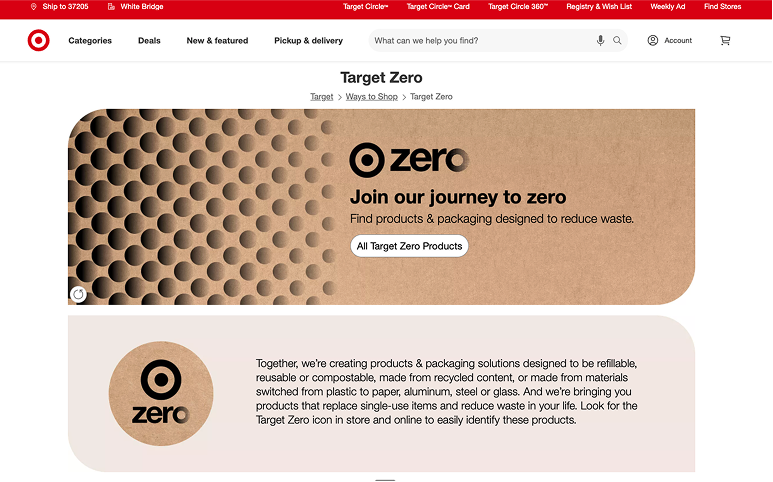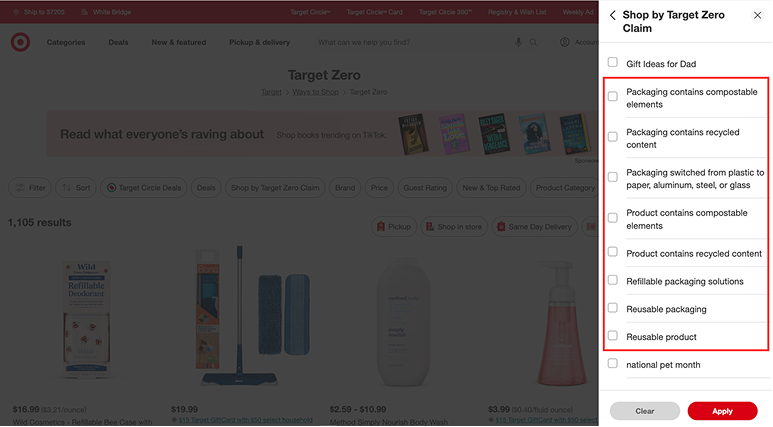The retail landscape is experiencing a green revolution, with consumers increasingly prioritizing environmental impact in their purchasing decisions. Target is responding to this demand by transforming how sustainable products are discovered, verified, and promoted through Target Zero. This flagship sustainability merchandising program connects eco-conscious shoppers across Target's 1,900+ store network with thousands of products designed to reduce waste and environmental impact.
The program isn't just about earning a badge, it's about connecting with 30M+ weekly Target guests who increasingly prioritize sustainability in their purchasing decisions. Target Zero serves as a signal to shoppers that participating brands are part of a more future-forward, sustainable assortment that aligns with their values.
What is Target Zero?
Target Zero is Target's comprehensive sustainability merchandising program that highlights products meeting rigorous standards across several sustainability pillars. A single product needs to qualify under just one of these pillars to earn the Target Zero badge in-store and online.
The Target Zero Pillars
Compostable products and/or packaging: Products and/or packaging made with materials certified to break down into organic matter under specific conditions.
Packaging alternatives: At least 50% of packaging must use plastic alternatives such as FSC-certified paper, aluminum, steel, or glass.
Recycled products and/or packaging: Products and/or packaging containing at least 30% post-consumer recycled (PCR) materials.
Reusable products and/or packaging: Products and/or packaging designed to be reused at the end of its initial use, in order to reduce waste.
Refillable products and/or packaging: Products and/or packaging designed with intention to be refillable in order to reduce overall waste.
Waterless or concentrated: Products that contain reduced water to minimize packaging and water use.
Products that meet one of these pillars earn the Target Zero badge, gaining enhanced visibility across Target's massive retail ecosystem.
How Target empowers shoppers to discover sustainable products
Beyond the badge, Target Zero products gain prime placement in search filters, category pages, and digital marketing campaigns. This multi-channel approach ensures that sustainability-focused shoppers can easily discover and purchase products that align with their values across Target's entire retail experience.
The program leverages Target's sophisticated e-commerce platform, which serves millions of daily visitors, to create dedicated sustainability landing pages and filtered search results. Shoppers can quickly identify Target Zero products through clear visual indicators both online and in-store.
How Target Zero breaks away from the pack
Massive scale and reach: One certification unlocks placement across Target's 1,900+ stores and digital platforms, reaching 30+ million weekly guests with unparalleled market penetration.
Integrated marketing power: Target Zero products benefit from Target's extensive marketing ecosystem, including circular ads, email campaigns, social media promotion, and in-store signage, amplifying brand visibility across multiple touch points.
Proven sales impact: Products in retailer sustainability programs have demonstrated up to a 12.5% sales lift within weeks of activation, as trust-building badges significantly influence consumer buying decisions.
Iconic US market presence: As one of the largest retailers in the US with over $100 billion in annual revenue, Target combines cultural influence with massive scale. From iconic store designs to major marketing campaigns, brands gain standout exposure in the highly competitive US retail landscape.
Streamlined onboarding: Target Zero's comprehensive yet flexible multi-pillar approach allows brands to find their best fit, while Novi's intuitive platform removes the guesswork for brands navigating the submission process.
Why did Target establish the Target Zero program?
Target recognized that sustainable shopping represents a fundamental shift in consumer behavior, not a passing trend. According to NYU Stern research, sustainable CPG goods drove nearly one-third of market growth between 2013 and 2023 despite holding less than one-fifth of market share. Additional insights from McKinsey indicate that 60-82% of consumers are willing to pay more for sustainable packaging.
Internally, Target Zero aligns with Target's comprehensive ESG strategy that commits to:
• Achieving net-zero emissions by 2040
• Eliminating waste in operations and helping guests reduce their environmental impact
• Sourcing more sustainably across all categories
• Creating economic opportunity within communities
Target Zero puts these commitments into action by bridging rising consumer demand with corporate sustainability goals to drive measurable impact across Target's retail strategy.
Who benefits from the program?
Shoppers gain a trusted, easy-to-identify way to find products that align with their sustainability values, supporting their environmental preferences while shopping at their favorite retailer.
Brands secure premium digital and in-store real estate to connect with values-driven consumers at massive scale. High-traffic web pages, targeted promotions, circular ad features, and in-store displays contribute to stronger visibility, deeper engagement, and ultimately, significant sales growth.
The planet benefits from increased availability and accessibility of sustainable products, driving positive environmental impact through mainstream retail channels.
Badged products signal value-on Amazon, Climate Pledge Friendly items saw a 12.5% sales lift within 12 weeks
How does Target Zero work?
For consumers:
- Look for the Target Zero badge to find verified sustainable products
- Shop via dedicated Target Zero landing pages and category filters

- Use sustainability-focused search terms and filters to discover qualifying products

- Access educational content about sustainability and product impact
For brands:
- Create a Novi account
- Upload SKU data for all products you wish to submit to the program
- Attest to the Target Zero pillars of your choosingAdjust any non-compliant SKUs where Novi flags gaps.
- Submit products for verification by Target's review team
- Benefit from Target covering Novi platform costs for participating brands
Put your purpose on display at Target with Novi
Target Zero represents Target's commitment to making sustainability mainstream. It is a comprehensive multi-pillar standard that celebrates innovation in packaging, ingredients, and product design. For conscious shoppers, it offers the transparency and education they seek, building trust and making it easier to find products that truly align with their values. For brands, it unlocks visibility across one of America's most beloved retailers and does so at a time when consumer demand for sustainable products is reaching new heights.
Whether you're launching your first sustainable product or have an entire portfolio ready to go, Novi makes Target Zero alignment seamless. Upload once, address gaps, and push badges straight to Target's product pages.
The future of retail is sustainable, and Target Zero is leading the way. By participating in this program, brands don't just earn a badge, they become part of a movement that's reshaping how America shops for a more sustainable future.
Ready to reach 30+ million weekly shoppers with your sustainable products? Sign up at Novi today to begin your Target Zero journey.



























